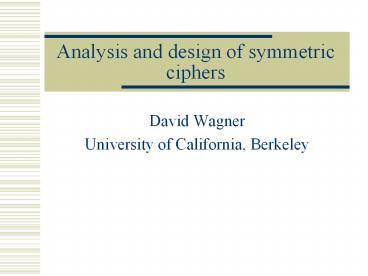Analysis and design of symmetric ciphers - PowerPoint PPT Presentation
1 / 27
Title:
Analysis and design of symmetric ciphers
Description:
byte re-ordering. One round. S(x) = l(l'(x)-1) in GF(28), where l,l' are GF(2)-linear. and the MDS matrix and byte re-ordering are GF(28)-linear. In this talk: ... – PowerPoint PPT presentation
Number of Views:20
Avg rating:3.0/5.0
Title: Analysis and design of symmetric ciphers
1
Analysis and design of symmetric ciphers
- David Wagner
- University of California, Berkeley
2
Whats a block cipher?
Ek X ? X bijective for all k
3
When is a block cipher secure?
Answer when these two black boxes are
indistinguishable.
4
Example The AES
One round
byte re-ordering
S(x) l(l(x)-1) in GF(28), where l,l are
GF(2)-linearand the MDS matrix and byte
re-ordering are GF(28)-linear
5
In this talk
How do we tell if a block cipher is secure? How
do we design good ones?
- Survey of cryptanalysis of block ciphers
- Steps towards a unifying view of this field
- Algebraic attacks
6
How to attack a product cipher
- 1. Identify local properties of its round
functions - 2. Piece these together into global properties of
the whole cipher
7
Motif 1 projection
- Identify local properties using commutative
diagrams
8
Concatenating local properties
- Build global commutative diagrams out of local
ones
9
Exploiting global properties
- Use global properties to build a known-text
attack
- The distinguisher
- Let (x, y) be a plaintext/ciphertext pair
- If g(?(x)) ?(y), its probably from Ek
- Otherwise, its from ?
10
Example linearity in Madryga
- Madryga leaves parity unchanged
- Let ?(x) parity of x
- We see ?(Ek(x)) ?(x)
- This yields a distinguisher
- Pr?(?(x)) ?(x) ½
- Pr?(Ek(x)) ?(x) 1
11
Motif 2 statistics
- Suffices to find a property that holds with large
enough probability - Maybe probabilistic commutative diagrams?
Prob. p
where p Pr?(Ek(x)) g(?(x))
12
A better formulation?
- Stochastic comm. diagrams
- Ek , ?, ? induce a stochastic process M
(hopefully Markov) ?, ?, ? yield M - Pick a distance measure d(M, M), say 1/M(x)
M(x)2 where the r.v. x is uniform on X - Then d(M,M) known texts suffice to distinguish
Ek from ?
13
Example Linear cryptanalysis
- Matsuis linear cryptanalysis
- Set X GF(2)64, Y GF(2)
- Cryptanalyst chooses linear maps ?, ? cleverly
to make d(M,M) as small as possible - Then M is a 22 matrix of the form shown here,
and 1/?2 known texts break the cipher
½? ½?
½? ½?
and d(M, M) 1/?2
14
Motif 3 higher-order attacks
- Use many encryptions to find better properties
X X
- Here weve definedÊk(x,x) (Ek(x), Ek(x))
Êk
X X
15
Example Complementation
- Complementation properties are a simple example
X X
- Take ?(x,x) x x
- Suppose M(?,?) 1 for some cleverly chosen ?
- Then we obtain a complementation property
- Exploit with chosen texts
Êk
X X
16
Example Differential crypt.
- Differential cryptanalysis
X X
- Set X GF(2)n, and take ?(x,x) x x
- If p M(?,?) 0 for some clever choice of ?,
? - can distinguish with 2/p chosen plaintexts
Êk
X X
17
Example Impossible diff.s
- Impossible differential cryptanalysis
X X
- Set X GF(2)n, and take ?(x,x) x x
- If M(?,?) 0 for some clever choice of ?, ?
- can distinguish with 2/M(?,?) known texts
Êk
X X
18
Example Truncated diff. crypt.
- Truncated differential cryptanalysis
- Set X GF(2)n, Y GF(2)m, cleverly choose
linear maps f1, f2 X ? Y, and take ?i(x,x)
fi(x x) - If M(?,?) 0 for some clever choice of ?, ?,
we can distinguish
X X
Êk
X X
19
Generalized truncated d.c.
- Generalized truncated differential cryptanalysis
- Take X, Yi, ?i as before then? maxx M(x)
M(x) measures the distinguishing power of the
attack - Generalizes the other attacks
X X
Êk
X X
20
The attacks, compared
generalized truncated diff. crypt.
truncated d.c.
l.c. with multiple approximations
impossible d.c.
differential crypt.
linear crypt.
complementation props.
linear factors
21
Summary (1)
- A few leitmotifs generate many known attacks
- Many other attack methods can also be viewed this
way (higher-order d.c., slide attacks, mod n
attacks, d.c. over other groups, diff.-linear
attacks, algebraic attacks, etc.) - Are there other powerful attacks in this
space?Can we prove security against all
commutative diagram attacks? - Were primarily exploiting linearities in ciphers
- E.g., the closure properties of GL(Y, Y) ?
Perm(X) - Are there other subgroups with useful closure
properties?Are there interesting non-linear
attacks?Can we prove security against all
linear comm. diagram attacks?
22
Part 2 Algebraic attacks
23
Example Interpolation attacks
- Express cipher as a polynomial in the message
key
- Write Ek(x) p(x), then interpolate from known
texts - Or, p(Ek(x)) p(x)
- Generalization probabilistic interpolation
attacks - Noisy polynomial reconstruction, decoding
Reed-Muller codes
24
Example Rational inter. attacks
- Express the cipher as a rational polynomial
- If Ek(x) p(x)/q(x), then
- Write Ek(x)q(x) p(x), and apply linear algebra
- Note rational polys are closed under
composition - Are probabilistic rational interpolation attacks
feasible?
25
A generalization resultants
- A possible direction bivariate polynomials
- The small diagrams commute ifpi(x, fi(x)) 0
for all x - Small diagrams can be composed to obtain q(x,
f2(f1(x))) 0, where q(x,z) resy(p1(x,y),
p2(y,z)) - Some details not worked out...
26
Algebraic attacks, compared
probabilistic bivariate attacks
prob. rational interpol.
bivariate attacks
probabilistic interpol.
rational interpol.
MITM interpolation
interpolation attacks
27
Summary
- Many cryptanalytic methods can be understood
using only a few basic ideas - Commutative diagrams as a unifying theme?
- Algebraic attacks of growing importance
- Collaboration between cryptographic and
mathematical communities might prove fruitful here































